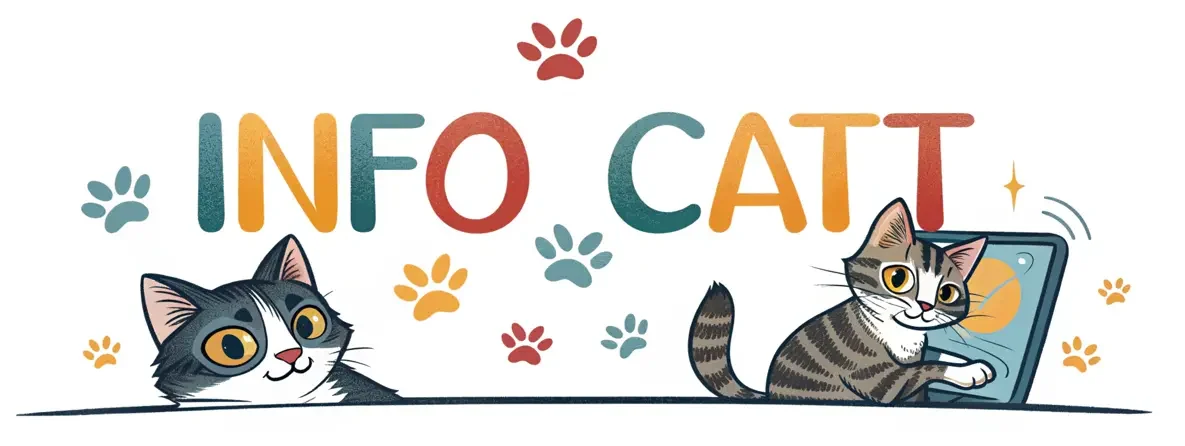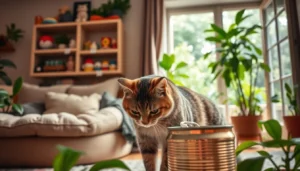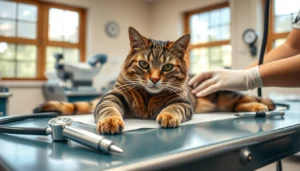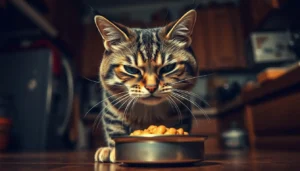Every cat owner has felt that sinking feeling when their cat won’t eat wet food. It’s a worry that something is wrong. Cat eating problems can be tough, making you want to give them the best food.
Wet food rejection is more common than you think. Knowing why your cat won’t eat wet food can help fix the issue. There are many reasons, from environmental changes to health problems.
In this guide, we’ll look at the top five reasons why cats might not eat their food. You’ll learn how to understand your cat’s eating habits. This will help ensure they get the nutrition they need to stay healthy.
Understanding Your Cat’s Natural Feeding Preferences
Cats are fascinating creatures with unique nutritional needs. These needs come from their wild ancestors. Knowing their natural feeding behaviors helps meet their dietary needs.
Domestic cats are similar to their wild counterparts in eating patterns. Their nutritional needs are complex, influenced by their hunting heritage.
Wild Cat Eating Patterns
In the wild, cats hunt small prey all day. Their preference for wet food reflects this natural hunting behavior. Cats usually:
- Hunt multiple times daily
- Consume moisture-rich prey
- Eat small, frequent meals
Instinctive Feeding Behaviors
Your cat’s eating habits show deep survival instincts. Prey-like food textures and fresh meals trigger their natural hunting responses. They prefer:
- Protein-rich foods
- Warm, soft textures
- Meals that resemble fresh catch
The Role of Texture and Temperature
Cats are very sensitive to food texture and temperature. Their sensory preferences guide their eating choices. Wet food often appeals more because it:
- Mimics natural prey moisture
- Provides essential hydration
- Offers a more appealing temperature
Understanding these natural preferences helps create a diet that satisfies your cat’s instinctive needs.
Recent Changes in Your Cat’s Environment That Affect Eating
Cats can be very picky about their food due to small changes in their environment. They are very sensitive to their surroundings. This can greatly affect their appetite and what they like to eat.
Some things that can make cats change their eating habits include:
- Relocating to a new home
- Introduction of new pets
- Significant household routine modifications
- Alterations in feeding location
- Changes in family dynamics
Cats like their routines. Stress and uncertainty can make them picky or stop eating. When their environment changes, they might eat differently as a way to cope.
To help your cat eat better during changes, make their environment stable and predictable. Keep their feeding times the same, use the same bowls, and give them a quiet place to eat. Slowly introduce new things to help them adjust.
Patience and understanding are crucial when helping your cat navigate environmental changes.
Keep an eye on your cat’s eating if they’re not eating well after changes. If they still don’t want to eat, it’s a good idea to talk to a vet. They can check if there’s a health problem.
Health Issues That May Cause Food Aversion
Cat health and food refusal can come from many medical conditions. These conditions can change how your cat eats. It’s important to know these health problems to understand why your cat might not want to eat wet food.
When your cat has trouble eating, it’s key to find the health issues behind it. This helps you know why they might not want to eat wet food.
Dental Problems and Oral Pain
Dental issues can make eating hard for your cat. Cats might not want to eat if they have:
- Tooth decay
- Gum inflammation
- Painful mouth ulcers
- Broken or loose teeth
These problems make eating wet food very painful. This is why your cat might not want to eat at all.
Digestive System Concerns
Digestive problems can be tough for cats. Gastrointestinal disorders like inflammatory bowel disease or intestinal infections can make your cat lose their appetite.
- Stomach upset
- Nausea
- Digestive tract inflammation
Upper Respiratory Infections
Respiratory infections can really affect your cat’s sense of smell. This can make them not want to eat. If your cat can’t smell their food, they might not be interested in eating.
A blocked nasal passage can make wet food seem unappealing to your feline friend.
If your cat keeps having trouble eating, see a vet. They can help find and treat health issues that might be affecting your cat’s nutrition.
Why Is My Cat Not Eating Wet Food: Common Behavioral Reasons
Understanding why cats are picky about food can be tough. Cats have their own likes and dislikes shaped by their experiences and instincts. Their eating habits often come from deep psychological and environmental factors.
There are several reasons why your cat might not want to eat wet food:
- Food Neophobia: Some cats are scared of new foods. They might not want to try new wet food textures or flavors.
- Negative past experiences with certain foods or brands.
- Learned preferences from when they were kittens.
- Sensitivity to food temperature, smell, or texture.
Cats often remember their food experiences. A bad experience, like getting sick from a certain wet food, can last a long time. Their pickiness might be a way to protect themselves, based on survival instincts.
Remember: Your cat’s food preferences are deeply personal and rooted in their unique experiences.
To help your cat, be patient and introduce new foods slowly. Watch how they react and respect their choices. Don’t push them to eat something they don’t want to.
The Impact of Food Temperature and Freshness
Your cat’s love for wet food can be affected by how warm it is and how fresh it is. Cats are known to be very picky. Knowing what they like can help avoid them turning down their food.
👉 Optimal Serving Temperature
Cats usually like their wet food a bit warm, like the temperature of their prey. To get it just right:
- Take the wet food out of the fridge 15 minutes before you serve it
- Warm it up by putting the dish in warm water
- Avoid using the microwave because it can make hot spots
👉 Storage and Preservation Tips
Keeping wet food fresh is important. Here’s how to do it right:
- Put opened wet food in the fridge right away
- Use airtight containers to store it
- Use it within 3-5 days after opening
- Keep it sealed to stop bacteria from growing
👉 Signs of Spoiled Wet Food
Knowing when wet food has gone bad is important for your cat’s health. Look out for these signs:
- Unusual odor that’s different from the usual smell
- Changes in color or mold
- A slimy or odd texture
- If your cat suddenly doesn’t want to eat
Keeping food quality high is essential to meet your cat’s high standards.
Brand and Formula Considerations for Picky Eaters
Dealing with picky cat eating habits can be like solving a puzzle. Different wet food brands have special formulas that might attract your picky cat. Knowing the differences between wet and dry cat food helps you choose the best for your pet.
When picking wet food for picky eaters, look at these important points:
- Protein source quality
- Texture variations
- Flavor complexity
- Ingredient transparency
Premium brands like Royal Canin and Wellness offer special recipes for different tastes. Some cats like chunky textures, while others prefer paté. Trying different brands can help find what your cat likes best.
“The secret to solving picky eating is understanding your cat’s individual palate.” – Veterinary Nutrition Expert
When switching to a new wet food brand, start by mixing it with what your cat already likes. Add a little of the new food to their usual meal. Watch how your cat reacts to the new food.
Every cat is different, so what works for one might not work for another. Being patient and watching your cat closely is key to managing their eating habits.
Transitioning Between Different Types of Cat Food
Changing your cat’s diet can be tough, thanks to their picky eating. Cats have special preferences, making it hard to introduce new foods. Knowing how to handle these changes is key to a smooth transition.
Patience is crucial when changing your cat’s diet. Cats like routine, and sudden changes can upset their stomachs or make them not want to eat.
👉 Gradual Introduction Methods
To smoothly change your cat’s diet, follow these steps:
- Begin by mixing a little new food with their usual diet
- Slowly add more new food over 7-10 days
- Watch how your cat reacts and eats during the change
- Keep feeding times and amounts the same
👉 Mixed Feeding Strategies
Using a mix of wet and dry food can help with diet changes. Try alternating between wet and dry food to keep things interesting and balanced. This is great for cats who like different textures.
👉 Dealing with Food Resistance
If your cat doesn’t like new foods, try these tips:
- Warm the food a bit to make it smell better
- Try different brands and flavors
- Make mealtime positive with treats and praise
- See your vet if your cat keeps resisting food
Remember, every cat is unique. What works for one may not work for another.
Conclusion
It can be tough to figure out what your cat needs to eat, even when they don’t want to eat wet food. It’s important to understand why they might not want to eat. Every cat is different, and their eating habits can be influenced by many things.
Figuring out why your cat doesn’t like wet food takes time and patience. You need to look at their eating habits closely. This can help you find out what’s not working for them.
Every cat is unique, so what works for one might not work for another. Talking to a vet can give you special advice for your cat. Pay attention to what your cat likes and doesn’t like, and be open to trying new things.
With the right effort, you can make your cat happy with wet food. Taking care of their diet is key to their health and happiness for a long time.
FAQ
Why is my cat suddenly refusing wet food?
Cats might stop eating wet food for many reasons. These include changes in their environment, health issues, or even just being picky. Even small changes can upset their eating habits. It’s key to find out why by watching their behavior and talking to your vet if they keep refusing food.
Could dental problems be causing my cat to avoid wet food?
Yes, dental pain can make eating wet food hard for cats. Problems like tooth decay or gum disease can hurt while eating. If your cat drops food or shows discomfort, a vet check is needed to find and fix any dental issues.
How can I encourage my cat to eat wet food?
Try warming the food a bit to make it smell better. Try different brands and flavors. Serve it at room temperature and make sure it’s fresh. Some cats like certain textures or proteins, so be patient and try different things. Mixing a little wet food with their favorite dry food might also help.
Is wet food really important for my cat’s diet?
Yes, wet food is key for cats. It has more moisture, which helps their kidneys and prevents urinary problems. It also has more protein and less carbs, which is better for them. Adding wet food to their diet can greatly improve their health and hydration.
Could stress be causing my cat to stop eating wet food?
Yes, stress can really affect a cat’s appetite. Changes like moving or introducing a new pet can cause anxiety. Cats like routine, so changes can make them not want to eat. Keeping their feeding area calm and consistent can help reduce stress and food aversion.
How long can a cat go without eating?
Cats should eat every 24-48 hours. Not eating for too long can lead to serious health problems such as fatty liver disease. If your cat hasn’t eaten in a day, see your vet right away. This could mean they have a serious health issue.
What temperature should I serve wet cat food?
Cats like their food at room temperature or slightly warm (around 86-90°F). Cold food might not smell as good and could be less appealing. You can warm it by letting it sit out or gently warming it in the microwave. Just be careful not to burn their mouth.



